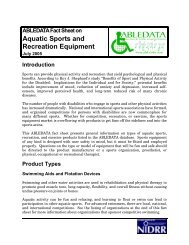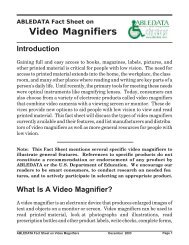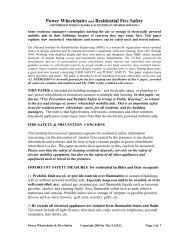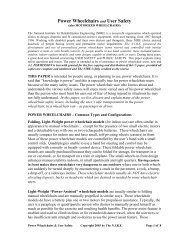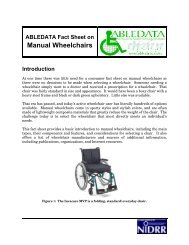Vision Aids for Impaired Peripheral Vision or Tunnel Vision - AbleData
Vision Aids for Impaired Peripheral Vision or Tunnel Vision - AbleData
Vision Aids for Impaired Peripheral Vision or Tunnel Vision - AbleData
Create successful ePaper yourself
Turn your PDF publications into a flip-book with our unique Google optimized e-Paper software.
height is trimmed so that it will fit onto the inside of the left carrier lens, toward the<br />
wearer’s left side. Both prism segments are edge-ground <strong>f<strong>or</strong></strong> smoothness where the cuts<br />
were made.<br />
By trial and err<strong>or</strong> testing, one lens at a time, the best location is determined <strong>f<strong>or</strong></strong> each prism<br />
segment. The prism should be just overlapping the user’s field of active vision while he<br />
looks ahead. The prism segments should not be so far toward center as to block, lessen <strong>or</strong><br />
interfere with the wearer’s direct central vision. When the optimum location is<br />
determined <strong>f<strong>or</strong></strong> each prism segment, it is cemented in place. The wearer is then taught to<br />
see clearly ahead, not through the prisms – but to move his eyes slightly, to see to the left<br />
<strong>or</strong> right, through the applicable prism. F<strong>or</strong> seeing farther to the right <strong>or</strong> left, the person<br />
rotates both his head and his eyes in the desired direction.<br />
Prism values should be the same <strong>f<strong>or</strong></strong> both eyes. Persons having unaided field widths of 120<br />
degrees can do well with weaker prisms, e.g. those of 10 to 20 prism diopters. Persons<br />
with field widths as low as 75 degrees may do best with stronger prisms, e.g. those of 20<br />
to 30 prism diopters. The key to good results lies with the attention and care given to<br />
testing and detail by the optical dispenser.<br />
TV-1A Prism Dynamics: The user must be able to see directly (not through the prisms)<br />
with both eyes in <strong>or</strong>der to see clearly, com<strong>f<strong>or</strong></strong>tably and be able to judge distance. The<br />
prisms must be far enough to each side so as to not block direct vision. When the user<br />
glances, momentarily to one side (right <strong>or</strong> left), he temp<strong>or</strong>arily sees far to his side but<br />
with only ONE EYE. He can see objects, people <strong>or</strong> obstacles to know they are there. But<br />
to see them clearly <strong>or</strong> to judge object size and distance, he would need to turn his head<br />
<strong>f<strong>or</strong></strong> direct observation with both eyes. EXPLANATION: Sight through the prism is with<br />
one eye; is momentary; and is to temp<strong>or</strong>arily substitute <strong>f<strong>or</strong></strong> the person’s missing<br />
peripheral vision. It augments, but does not replace, the person’s direct vision. People<br />
with unaided field widths of 120 degrees have the prisms placed farther to each side than,<br />
say, people with unaided field widths of 75 degrees. Images seen through the prisms appear in<br />
n<strong>or</strong>mal size. Type TV-1A eyeglasses are the most effective field-expanding eyeglasses, and<br />
the most convenient and natural to use. They are the preferred type <strong>f<strong>or</strong></strong> people having<br />
unaided visual field widths of 75 to 120 degrees. Prismatic FX devices expand vision to the<br />
side - but not up <strong>or</strong> down. Accessing these prisms is not m<strong>or</strong>e difficult than other people’s use of<br />
bifocal lenses. The needed eye and head movements become automatic with use.<br />
Other types of field-expanding eyeglasses, described below, are best <strong>f<strong>or</strong></strong> people whose<br />
unaided visual field widths are less than 75 degrees. All are “Tubular” FX devices<br />
which expand vision up and down, as well as to the sides. The user sees a circular,<br />
minified image of the room <strong>or</strong> outside area. A “Linear” FX device gives the sharpest,<br />
dist<strong>or</strong>tion free view – but cannot show as large an outside area as a “Non-Linear” FX<br />
device. People having larger unaided visual field widths often choose linear FX devices<br />
… while those with smaller unaided field widths often choose non-linear FX devices,<br />
provided they have n<strong>or</strong>mal <strong>or</strong> near-n<strong>or</strong>mal acuity. Designing field-expanding eyeglasses<br />
<strong>f<strong>or</strong></strong> people having unaided visual field widths less than 20 degrees involves many choices<br />
and compromises and is, there<strong>f<strong>or</strong></strong>e, complex.<br />
6 <strong>Tunnel</strong> <strong>Vision</strong> Copyright 2003 by The N.I.R.E. Page 6 of 13



